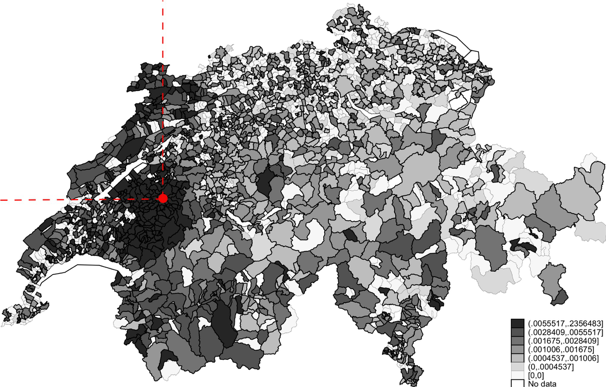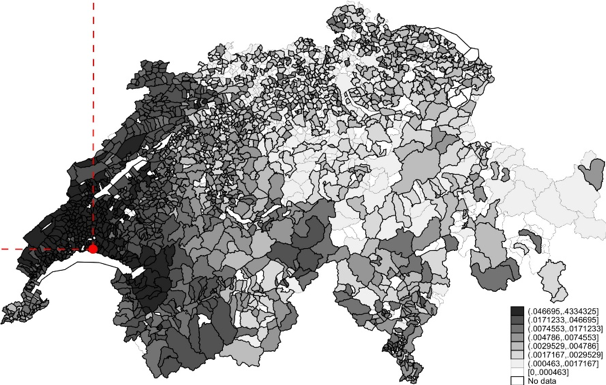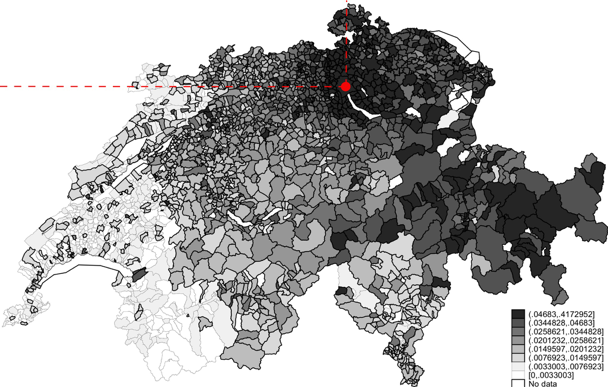It is an old, yet unanswered question. What is the role of culture in explaining individual differences in economic activity, and in particular, in founding successful firms? Since firm entry is widely viewed as a central driver of economic growth – it accounts for 25% of US productivity growth, according to Foster et al. (2001) – answering this question can help us to understand persistent differences in economic development across regions that common explanatory factors cannot accommodate.
Both economists and sociologists have studied this question for more than a century (Hoselitz 1957, Leff 1979 and Weber 1905). Nonetheless, causal evidence remains scarce. This is not surprising, because typically, we cannot separate the effect of culture on individual decisions from the institutional environment of these individuals. In fact, it seems the only way to answer this question would involve an (unfeasible) experiment. After randomly assigning individuals of different cultural backgrounds to identical environments, we could cleanly analyse the differences in their entrepreneurial activity as well as the aggregate economic implications thereof.
A quasi-experiment at the Swiss language border
In a recent paper (Erhardt and Haenni 2018), we exploit two institutional features of Switzerland that help us to obtain a quasi-experimental setting of that very flavour. The first is the concept of place of origin – an institution dating back to the 18th century – which until today is recorded for every Swiss citizen in lieu of the place of birth that is commonly recorded in other countries. The place of origin is the municipality where one’s ancestors had the right to common goods. It is passed down from generation to generation through the paternal line and has remained unchanged for centuries, no matter where a person lives today. The concept has its roots in medieval times when established citizens were hesitant to share common goods with new residents and provoked a separation of place of origin and place of residence. This institution was later standardised in the Helvetic constitution of 1798. During the course of the 19th and 20th century, the place of origin gradually lost all its competences to the place of residence as more and more people started to move away from their ancestors’ place of origin. While in 1860 59% of Swiss citizens lived at their place of origin, this share decreased to 34% by 1910. Today, in the median Swiss municipality, only 14% of its residents have their place of origin in this very municipality.
Figure 1 shows the distribution of places of origin for three major cities located in different language regions of multilingual Switzerland: Fribourg is located right on the language border, Lausanne is located in the French-speaking region, and Zurich is located in the German-speaking region. We see that in all three cities, individuals have their place of origin in all parts of the country, but in a gravity-like pattern, the density decreases with distance to the place of residence. In our setting, the place of origin provides an ideal measure for the origin of the family of an entrepreneur that is not affected by today’s policies and institutions. In combination with the place of residence, it allows us to disentangle cultural origin from current environmental influences.
The second feature, and the one that allows us to assign different places of origin to different cultural origins, is the Swiss language border. This language border provides a unique empirical opportunity to identify cultural effects for three reasons. First, the language border is also a cultural border where values and norms diverge, as documented in several previous studies (Eugster and Parchet 2019, Eugster et al. 2017, Eugster et al. 2011, Brown et al. 2018). Second, the predominantly spoken language changes sharply at the language border. Within a distance of just a few kilometres, the share of native French language speakers changes from more than 90% to less than 10% on the German-speaking side of the language border, and vice-versa. Lastly, at the same time, the language border largely runs within cantons (states), holding laws and institutions constant on both sides.1
Figure 1 Share of individuals from each place of origin living in three major cities
(a) Fribourg
(b) Lausanne
(c) Zurich
Note: Darker colours indicate higher population shares from a certain place of origin living in the respective cities.
In order to measure entrepreneurial activity, we make use of a newly compiled data set on the universe of firms founded in Switzerland between 2002 and 2016. Specifically, these data provide information on the place of origin as well as on the place of residence of firm founders. We complement the data with information on the overall distribution of residents in each Swiss municipality by place of origin as well as with the respective nearest distances of these places of origin to the language border.
In the spirit of the ideal experiment outlined earlier, we contrast the entrepreneurial activity of individuals that are exposed to the same economic environment – people living in the same municipality – but have their cultural origin just on different sides of the language border in a spatial regression discontinuity design. While we focus on firm founders with cultural origins around the language border, the municipalities of residence considered in the analysis are all municipalities in Switzerland.
Does cultural origin affect the emergence of new firms?
We find that individuals with their cultural origin on the German-speaking side of the Swiss language border founded 20% more firms than individuals who live in the same municipality but who have their cultural origin on the French-speaking side. Importantly, we can exclude any market-specific explanations as this difference is found independently of the current location of individuals. We find an effect of the same magnitude when considering individuals that live in the French-speaking part of Switzerland only, or, vice versa, when considering solely individuals that live in the German-speaking part.
While the baseline results already suggest a strong persistence of the cultural component, we provide further evidence on the persistence of the effect by focusing only on individuals who carry a first name that is characteristic of their current place of residence. In that exercise, we compare only individuals who live in the same municipality and who have a first name that is characteristic of their respective municipality of residence but who are of different cultural origin. As an example, we can think of comparing two individuals that both live in Geneva and who carry a typical French first name, such as Fran¸cois, but who have their respective cultural origins on different sides of the language border in the German-speaking and the French-speaking region, respectively. Even in this sub-sample of fully assimilated individuals, we find that individuals with their cultural origin on the German-speaking side of the Swiss language border founded 18% more firms than those with their cultural origin on the French-speaking side.
As an instructive exercise to further emphasise that the identified effect is solely driven by different cultures and not by an omitted channel that simultaneously changes discontinuously at the language border, we re-estimate the effect separately for different sections of the language border. In particular, we consider the cultural origins of each of the three bilingual cantons separately. These three language border sections are geographically not connected and up to 200km apart from each other. Importantly, they lie in rather different institutional environments and have a different composition of economic activity. We show that the differences across cultural backgrounds exist independently in each of these three cantons, which credibly excludes any non-cultural channels such as differences in wealth endowment.
Does the firm life cycle depend on the cultural origin of the founder?
In the second part of our empirical analysis, we complement the firm registry data with data on firm-level characteristics and examine whether firms that are founded by individuals of different cultural origins differ in their types or economic success. First, we repeat the main exercise for each sector of the economy and each legal form separately. The results show that similar differences in firm founding rates exist for all these firm types. This is first evidence that firms, once founded, are remarkably similar across founders with cultural origin from both language regions. Second, when contrasting firm-level outcomes such as bankruptcy, employment size, and revenues along the life cycle of firms we find again that, once founded, firms are identical for founders of both cultural origins.
How can we reconcile the empirical results?
We rationalise these findings in a theoretical model of entrepreneurial choice that allows for three commonly discussed individual determinants of entrepreneurship: risk aversion, entrepreneurial skill, and sheer preferences for entrepreneurship. In our model, individuals decide whether to become regular workers, obtaining a risk-free income, or to become entrepreneurs, obtaining a risky profit that is increasing in individual entrepreneurial abilities.
The model suggests that the empirical finding, namely, the observation of higher firm founding rates for individuals of German-speaking origin, combined with identical measures of entrepreneurial success across founders with different cultural origin, can be explained either by differences in risk aversion or differences in preferences for being self-employed, but not by differences in skills alone. These results are supported by survey data across these two cultural areas from both entrepreneurs and the general population, which point towards risk aversion being the dominant factor. Taken together, our findings have sizeable economic implications. Specifically, the observed differences in net entry rates account for around 120,000 additional jobs that have been created by entrepreneurs of German-speaking origin solely over the 15 years covered in our data. This amounts to 2.5% of current employment in Switzerland.
References
Brown, M, C Henchoz and T Spycher (2018), “Culture and financial literacy: Evidence from a within-country language border”, Journal of Economic Behavior & Organization 150: 62-85.
Erhardt, K and S Haenni (2018), “Born to be an entrepreneur? How cultural origin affects entrepreneurship”, ETH Zurich working paper.
Eugster, B, R Lalive, A Steinhauer and J Zweimüller (2011), “The demand for social insurance: Does culture matter?”, Economic Journal 121(556): 413-448.
Eugster, B, R Lalive, A Steinhauer and J Zweimüller (2017), “Culture, work attitudes and job Search: Evidence from the Swiss language border”, Journal of the European Economic Association 15(5): 1056-1100.
Eugster, B and R Parchet (2019), “Culture and taxes”, Journal of Political Economy 127(1): 296-337.
Foster, L, J Haltiwanger and C J Krizan (2001), “Aggregate productivity growth: Lessons from microeconomic evidence”, in Hulten, C R, E R Dean and M J Harper (eds), New developments in productivity analysis, p. 303-372, Chicago: University of Chicago Press.
Hoselitz, B F (1957), “Noneconomic factors in economic development”, American Economic Review 47(2): 28-41.
Leff, N H (1979), “Entrepreneurship and economic development: The problem revisited”, Journal of Economic Literature 17(1): 46-64.
Weber, Max (1905), The protestant ethic and the “spirit” of capitalism, Archiv für Sozialwissenschaften und Sozialpolitik.
Endnotes
[1] We focus on the Swiss-German/Swiss-French language border for three reasons. First, it comprises the two main language regions of Switzerland accounting for 86% of the total population. Second, the Swiss-German/Swiss-French language border runs within cantons, thereby providing a very sharp spatial separation of the language regions while institutions remain the same. To see this, note that most institutions and policies are set at the cantonal level, especially in the historical context that we will exploit later on. Third, the Swiss-German/Swiss-French language border does not follow the main geographical barriers.







